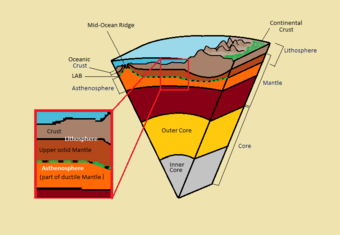Astronomy:Lithosphere-Asthenosphere boundary
The Lithosphere-Asthenosphere boundary (LAB) represents a mechanical difference between layers in Earth’s inner structure. Earth’s inner structure can be described both chemically (crust, mantle, core) and mechanically. The Lithosphere-Asthenosphere boundary (referred to as the LAB by geophysicists) lies between Earth's cooler, rigid lithosphere and the warmer, ductile asthenosphere. The actual depth of the boundary is still a topic of debate and study, although it is known to vary according to the environment.[1]
Defining the LAB
The LAB is determined from the differences in the lithosphere and asthenosphere including, but not limited to, differences in grain size, chemical composition, thermal properties, and extent of partial melt; these are factors that affect the rheological differences in the lithosphere and asthenosphere.
The lithosphere-asthenosphere boundary represents a rheological boundary. Colder temperatures at Earth's shallower depths affect the viscosity and strength of the lithosphere. Colder material in the lithosphere resists flow while the "warmer" material in the asthenosphere contributes to its lower viscosity. The increase in temperature with increasing depth is known as the geothermal gradient and is gradual within the rheological boundary layer. The lithosphere is the portion of the thermal boundary layer commonly defined by its purely conductive heat transport. Throughout the rheological boundary, the geotherm gradually transitions from the conductive nature of the lithospheric geotherm to the convective (adiabatic) nature of the underlying asthenosphere.[2] Sometimes other definitions of the asthenosphere and LAB are used, e.g. seismic asthenosphere is a layer of low velocity and high attenuation of the seismic waves.[3] Moreover, the rheology of the rocks depends also on the stress tensor. It means that asthenosphere could be of thermal and/or mechanical origin.[4]
Gutenberg Discontinuity
The LAB is often observed and imaged via signal processing techniques and seismic waves. Seismic tomographic studies suggests that the LAB is not determined by a purely thermal model, but rather it is affected by the presence of partial melt material in the asthenosphere. Evidence from converted seismic phases indicates a sharp decrease in shear-wave velocity 90–110 km below continental crust.[5] Recent seismological studies indicate a 5 to 10 percent reduction in shear-wave velocity in the depth range of 35 to 120 km beneath ocean basins. The seismic discontinuity often associated with this sharp contrast in wave velocity and presence of partial melt is known as the Gutenberg discontinuity or "G" to many geophysicists. The Gutenberg discontinuity coincides with the expected LAB depth in many studies and has also been found to become deeper under older crust, thus supporting the suggestion that the discontinuity is closely interrelated to the LAB.[6]
Beneath oceanic lithosphere
Beneath oceanic crust, the LAB ranges anywhere from 50 to 140 km in depth except at mid-ocean ridges where the LAB is no deeper than the depth of the new crust being created.[7] Seismic evidence shows that oceanic plates do thicken with age. This would suggest that the Lithosphere-Asthenosphere boundary underneath oceanic lithosphere also deepens with plate age. Data from ocean seismometers indicate a sharp age-dependent LAB beneath the Pacific and Philippine plates and has been interpreted as evidence for a thermal control of oceanic-lithosphere thickness.[8][9]
Beneath continental lithosphere
The continental lithosphere contains an ancient, stable part known as the craton. The LAB is particularly difficult to study in these regions and evidence suggests that the lithosphere within this old part of the continent is at it thickest and even appears to exhibit large variations in thickness beneath the cratons,[10] thus supporting the theory that lithosphere thickness and LAB depth are age-dependent. Depths of the LAB beneath these regions (also known as shields and platforms) are estimated to be between 200 and 250 km deep.[11] Beneath Phanerozoic continental crust, the LAB is roughly 100 km deep.[11]
References
- ↑ Rychert, Catherine A.; Shearer, Peter M. (24 April 2009). "A Global View of the Lithosphere-Asthenosphere Boundary". Science 324 (5926): 495–498. doi:10.1126/science.1169754. PMID 19390041. Bibcode: 2009Sci...324..495R.
- ↑ Sleep, Norman (2005). "Evolution of the Continental Lithosphere". Annu. Rev. Earth Planet. Sci. 33: 369–393. doi:10.1146/annurev.earth.33.092203.122643. Bibcode: 2005AREPS..33..369S.
- ↑ Jones, A. G., Plomerova, J., Korja, T., Sodoudi, F., & Spakman, W., 2010. Lithos, 120(1-2), 14-29. DOI: 10.1016/j.lithos.2010.07.013
- ↑ http://meetingorganizer.copernicus.org/EGU2016/EGU2016-10917.pdf
- ↑ Rychert, Catherine; Fischer, Karen; Rondenay, Ste´phane (July 2005). "A sharp lithosphere–asthenosphere boundary imaged beneath eastern North America". Nature 436 (28): 542–545. doi:10.1038/nature03904. PMID 16049485. Bibcode: 2005Natur.436..542R.
- ↑ Schmerr, Nicholas (2012). "The Gutenberg Discontinuity: Melt at the Lithosphere-Asthenosphere Boundary". Science 335: 1480–1483. doi:10.1126/science.1215433. Bibcode: 2012Sci...335.1480S.
- ↑ Pasyanos, Michael (2008). Lithospheric thickness modeled from long period surface wave dispersion. https://e-reports-ext.llnl.gov/pdf/361453.pdf. Retrieved 26 March 2015.
- ↑ Kawakatsu, Hitoshi; Kumar, Prakash; Takei, Yasuko; Shinohara, Masanao; Kanazawa, Toshihiko; Araki, Eiichiro; Suyehiro, Kiyoshi (2009). "Seismic Evidence for Sharp Lithosphere-Asthenosphere Boundaries of Oceanic Plates". Science 324 (499): 499–502. doi:10.1126/science.1169499. PMID 19390042. Bibcode: 2009Sci...324..499K.
- ↑ Fischer, Karen M.; Ford, Heather; Abt, David; Rychert, Catherine (2010). "The LithosphereAsthenosphere Boundary". Annual Review of Earth and Planetary Sciences 38: 551–575. doi:10.1146/annurev-earth-040809-152438. Bibcode: 2010AREPS..38..551F.
- ↑ Eaton, David; Darbyshire, Fiona; Evans, Rob; Grutter, Herman; Jones, Alan; Yuan, Xiaohui (2009). "The elusive lithosphere–asthenosphere boundary (LAB) beneath cratons". Lithos 109: 1–22. doi:10.1016/j.lithos.2008.05.009. Bibcode: 2009Litho.109....1E.
- ↑ 11.0 11.1 Plomerova, Jaroslava; Kouba, Daniel; Babusˇka, Vladislav (2002). "Mapping the lithosphere–asthenosphere boundary through changes in surface-wave anisotropy". Tectonophysics 358: 175–185. doi:10.1016/s0040-1951(02)00423-7. Bibcode: 2002Tectp.358..175P.


